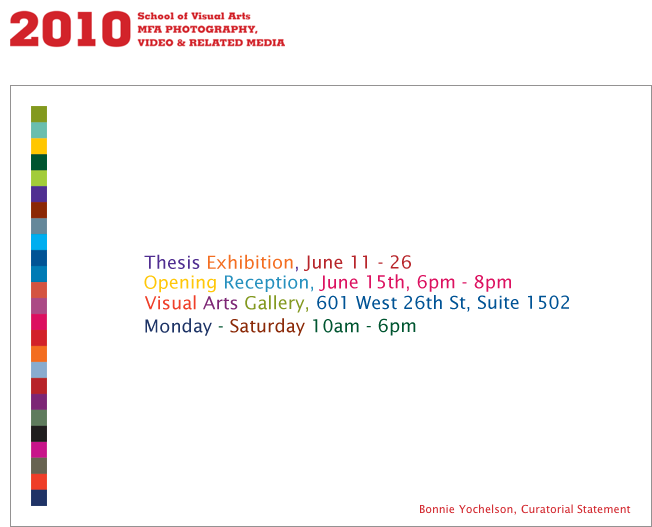 It's hard to believe that a year ago was my SVA MFA Thesis show. Tonight is the opening for this year's crop of artists. I'm looking forward to seeing how their work developed over their Thesis year of school.
It's hard to believe that a year ago was my SVA MFA Thesis show. Tonight is the opening for this year's crop of artists. I'm looking forward to seeing how their work developed over their Thesis year of school.
Hopefully, I'll see you at the show tonight. Also, be sure to check out this year's Thesis web site at: http://mfaphoto.schoolofvisualarts.edu/thesis2010/index.php
This years' thesis exhibition features the work of:
IRENE BERMUDEZ ŽELJKA BLAKŠIĆ LORNE BLYTHE JOHN CYR BEATRIZ DIAZ JOHN DUNWOODY NATAN DVIR JANOSCH PARKER MARTHA FLEMING-IVES J.A. FOLKS ROBERT GILL EUGENE GOLOGURSKY KATE GREENBERG DEBBIE GROSSMAN STONE KIM TAMAR LATZMAN VIVIAN LEE ELIZABETH LIBERT DINA LITOVSKY JOHN A. MESSINGER LAURA OBERG ALLYSON ROSS SELENA SALFEN ANDREA SANTOLAYA LEIGH WELLS
Opening Reception Tuesday, June 15th 6-8pm
Gallery Hours: Mon.-Sat. 10AM-5PM
Visual Arts Gallery 601 W 26h Street, Suite 1502 New York, NY View Map
Our awkward program name – photography, video, and related media – is becoming ever more apt. This year, the thesis show includes photographic prints, videos, multi-media installations, sculpture and oil paintings. With the swift advance of digital technology, students are using still or moving images merely as points of departure to invent a wide array of forms. Željka Blaskic, for example, produces a five-channel video installation inspired by her childhood in war-torn Croatia. Jan Ebeling (aka Janosch Parker) commissions oil paintings based on photographs of his witty performances. Irene Bermudez combines projected images, freestanding sculpture and a neon sign to create an immersive environment meant to evoke bodily sensations. Allyson Ross creates sculptural reliefs devoid of color based on iconic nineteenth-century photographs of Yosemite National Park. And John Messinger installs a small historical exhibit based on the life of a homeless man. These results and others are exciting to behold and, I confess, daunting for a curator trying to make visual or conceptual order from it all.
If there is an overall trend, it is the trust that students place in personal experience. Robert Gill, for example, embraces the obsession with fitness in our culture. Selena Salfen explores the crushing effects of post-traumatic stress disorder through the history of her own family. Tamar Latzman investigates themes from Jewish-European history by inventing memories of dreams and performing them for the camera. And Laura Oberg explores race in America by interviewing members of her mixed-race family. It may be that the confessional turn of our culture – much enhanced by social networking media – explains the willingness of students to reveal themselves in their work. But the students are not self-centered; they look inward in order to look outward. Growing up with the caveats of identity politics and challenges to the objectivity of representation, our students no longer feel at home with the relatively simple norms of documentary or straight photography. Instead, each student invents a new strategy for using images to make art.
–Bonnie Yochelson Curator
